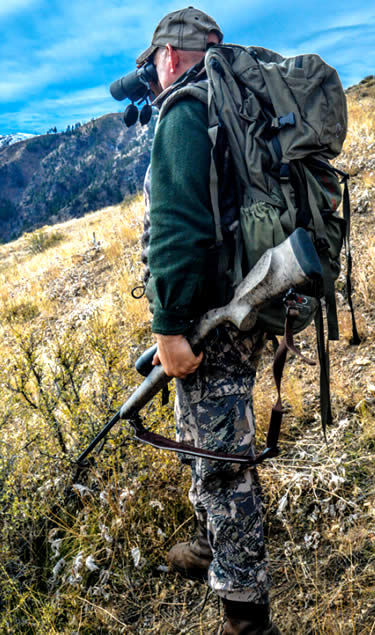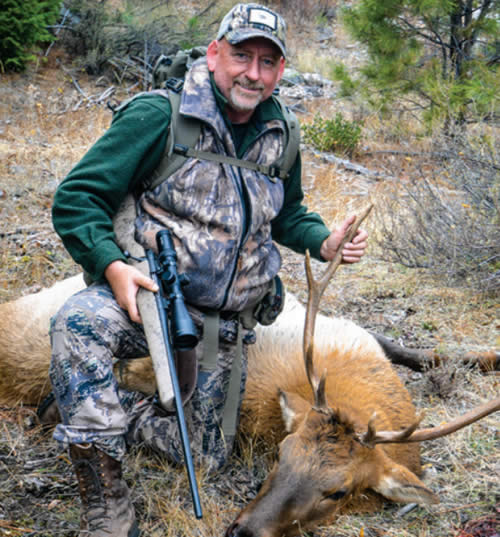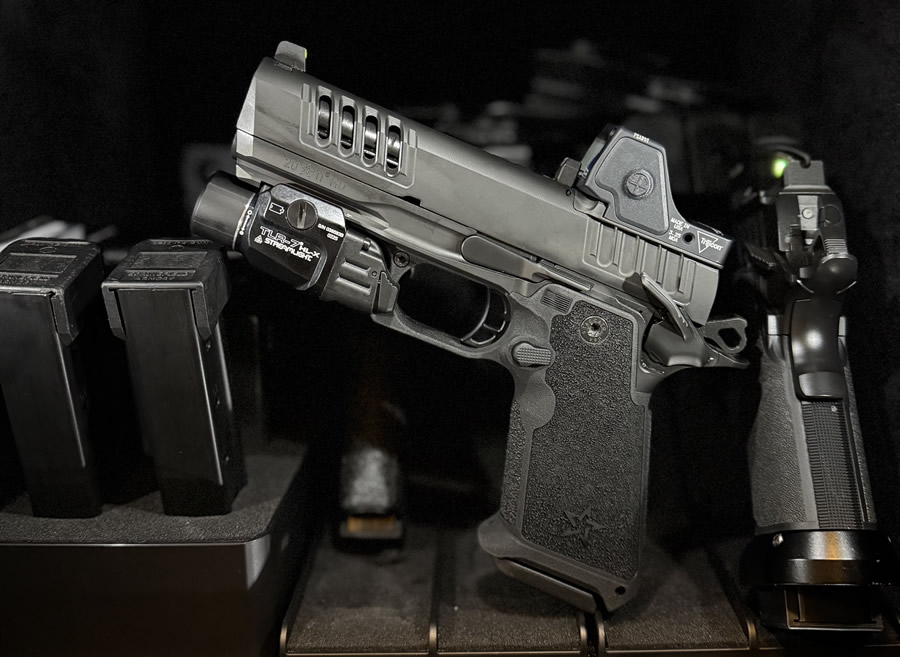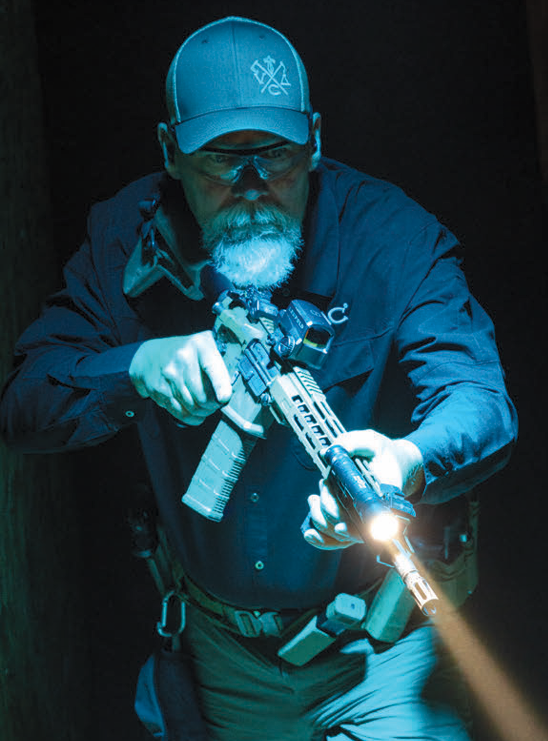Long-range shooting is all the rage, but it will never replace old-fashioned fieldcraft for stalking big game. Here are one rifle hunter’s tricks.
Story and PHotos by Jason BrooksClimbing up out of the steep drainage overlooking Idaho’s Salmon River, I took a quick glance to the
far hillside and confirmed the elk were still there. Earlier that morning we had planned to check a spot that is known to hold elk when they get pressured from other hunters. Sure enough, the bench and
open slope above were being used as a safe haven by a herd with a few bulls in it.

outline to blend into the landscape and stay
hidden from the animals you seek.
It was time to make a plan and close the distance. I had killed a bull on this very same hillside three years earlier and have been hunting this mountain for nearly 30 years, so when my hunting partner Russ McClellan asked me for my thoughts on how we were going to get within shooting range, my answer was simple: “We need to be tactical about it, as they can see us coming from below, the wide-open slope means we can’t stalk directly to them, and it’s too far of a shot from here.”
Hunters often forget how to overcome obstacles to close the distance to game. With all the modern advances in long-range shooting, it seems the average hunter is starting to lose the ability to stalk game. Why would a hunter need to expend their energy – or risk busting a herd of elk, causing them to flee to the next mountain range – if they can just shoot from the perch they are on? Well, it is part of
hunting and though it takes a serious set of skills to make long-distance shots, it is also rewarding to get as close as possible to the animal. It is why bowhunting is still extremely popular, as it adds to the hunt. But with younger generations of hunters learning to shoot far distances, they are foregoing one of the most basic concepts of hunting game and that is to actually “hunt” the animal.
Closing the distance between hunter and prey is but one of the reasons why many of us take the field.
It is a challenge and is very satisfying to sneak in on an animal and make an ethical shot. Not only does it add to the hunt, but it also makes you a better hunter. Finding game and then stalking it is rewarding in itself, even if you do not end up filling the tag, and it is becoming a lost art of sorts.
LEGENDARY BOWHUNTER AND bow manufacturer Fred Bear is known for several words of wisdom, including, “The best camouflage pattern is called, ‘Sit down and be quiet!’ Your grandpa hunted deer in a red plaid coat.” This is true, but do not overlook camo as part of your tactical gear. When it comes to “tactics,” there are two terms often used interchangeably: cover and concealment. For those in the military and law enforcement worlds, cover and concealment work together but mean different things. Cover is used to protect the person from the threat while also concealing their location. Concealment is being hidden but with no protection. For the hunter, they can be used interchangeably for the most part.

underneath a ponderosa pine to conceal
yourself while waiting for game.
Using cover can be as simple as sitting in a ground blind over a water hole or tucking in behind a large tree. You can’t see through the tree and must peek out a window of the blind; in essence, you are “covered up” until you expose yourself to take a peek.
Concealing yourself is more than just using a sagebrush bush to break up your outline, but this is the basic idea. Try to keep something between you and the animal you are stalking. One way to do this is to cover ground slowly from “point to point,” meaning going from one object to another. For example, using a tree for cover until you get to the next tree, then finding another object to keep between you
and the prey.
One way to stalk an animal using cover and concealment is to use the terrain itself. Last spring we found a flock of turkeys in a farmer’s field that we had permission to hunt. Noticing a small depression in the field, we crawled over to it and realized it was about an 8-foot drop from the top to the bottom. This allowed us to walk along until we were even with the birds and then crawl up and place a hen
decoy, as if it had just walked up out of the same depression, while we lay in wait for the tom to come strutting over.
Another time we sat inside of a pine tree. This meant sitting at the base of the tree and using the branches to conceal our outline. One of the branches also made for a good shotgun rest. This tactic can be used for whitetail and the Columbian blacktail where I live in western Washington state, as they tend to use the trails throughout the day.
For the mule deer hunter, this might mean sitting in a hidden spot, such as behind a boulder or up against a sagebrush bush, and watching a well-used saddle between north- and south-facing slopes.

terrain to conceal yourself while glassing and
sneaking up on game.
I always find it odd to look around with binoculars and see hunters sitting out on an open slope or on a ridgeline. They stick out like a sore thumb and are easy to spot, not just by me but by any animal that calls that place home. When on a ridge, it is best to hike a few feet below the ridgeline. If you want to
look over the other side, then crouch down and use a tree or some other object to conceal yourself, approach it, and then peek over.

of elk while using distance as a way to
keep from being seen during the stalk.
DISTANCE IS OFTEN overlooked as a concealment method. Thinking back to that herd of elk we found above the river drainage, when I was asked how we would stalk that group of elk, I knew that the only cover we had was distance. Heading back down and hiking to the next ridge that came down from the peak above, we made our way up a small drainage on the backside. Once we got to the top, we cut across the face nearly a mile away from the elk. We could look down on them and see they were still there, in their safety zone on that bench. The elk were wary of predators that would come up from below, and though we were well within sight of the sentry cow, the herd never once looked up, probably because the slope was wide open and the morning thermals were still blowing down. We were so far above them that our scent never made it down to them and they could not see us.
The weather is another tactic that hunters overlook. If barometric pressure is changing, this means breezy conditions. If a storm is approaching from the west, you should hunt from the east, into the wind. With today’s modern technology and so many weather apps on cell phones, there really is no excuse for not knowing the forecast. My favorite app is called Windy (windy.com), which provides precise wind direction and speed and the map is incredibly detailed. You can see what the wind is doing on the next ridge, basin or mountain over, so if you need to plan a stalk, you know which direction to approach from. Knowing the wind direction is a serious game-changer and is one that is often overlooked by hunters. When you can predict weather down to the hour, this can be a big advantage when thinking tactically. If a system is about to move in, then position yourself so that when it does hit you are already in a vantage point to intercept animals.
Years ago, the very first buck I ever killed was during a major windstorm. It had snowed all night and now the clouds were being pushed out of the area with a pressure change. I sat in a saddle; one side was windward and powdered snow was flying, but the other side was leeward and calm. As I sat in the saddle, I knew that no deer was going to leave the warm and calm basin to my left, so I faced to the right and waited. An hour later, a small buck seeking refuge on the other side of the saddle walked right to me.
SUNLIGHT IS NOT often thought of as something that a hunter can utilize, but it should be considered. I prefer to hunt from east to west in the morning and then west to east in the afternoon. This basically always keeps the sun to my back, allowing me to see much better, plus it can blind my quarry.
A few years ago I was hiking along an open alpine meadow when I jumped a cow elk. It was an “any elk”
unit and I was not about to turn down the opportunity at a cow. She stood there trying to figure out what I was, as she was staring directly back into the sun. I could see her easily and had plenty of time to take the shot. You should think about things like the sun’s position in the sky, wind direction and even time of day when stalking an animal. If it is midday and the animal is content, then it is likely to still be there when you get there.
But if it is late in the day, the prey might get up to feed. Early morning is very unpredictable when it comes to animal behavior. They might feed longer if the night was cold or wet, they might lay down, or they might adjust their bed several times before settling down for the day. Patience is the hardest tactic to learn, but sometimes just watching an animal for a few hours will give you enough intel to help you choose the right tactics to close the distance.

when sneaking up on big game. By keeping
it at your back in the morning and evening,
animals may not detect your approach.
BACK TO THAT elk hunt in Idaho. After we climbed to the top of the mountain, it was time to make the final approach. We had used distance as cover and had worked the thermals, knowing that when we
first spotted the elk our scent was being carried downhill. Now it was midafternoon and as we approached from above, the thermals carried our scent up and away from the elk.

with the author while they used terrain,
distance and patience to stalk an elk herd.
A sharp knife-edge ridge led down to the elk, and it had several rock outcroppings on it. Keeping the rocks between the elk and ourselves, we kept our outlines concealed. Finally making our way to just above the elk, we spotted a five-point bull lying next to some small pine trees, surrounded by a group of cows. A bugle let off to our right and I found another five-point raking some trees in a small depression in the shade of the saddle below. A lone sagebrush bush between me and that bull meant I could sneak down to get a clear shot. My hunting partner Russ stayed put and said he would take the first five-point we’d spotted after I took the first shot, since my bull was standing.
It all worked out. Six hours after we first spotted the elk, I shot and killed a nice Idaho bull. The second bull and the cows had no idea what happened; as they stood looking around, Russ took his shot. We doubled up on two five-point bulls because we were tactical hunters.











